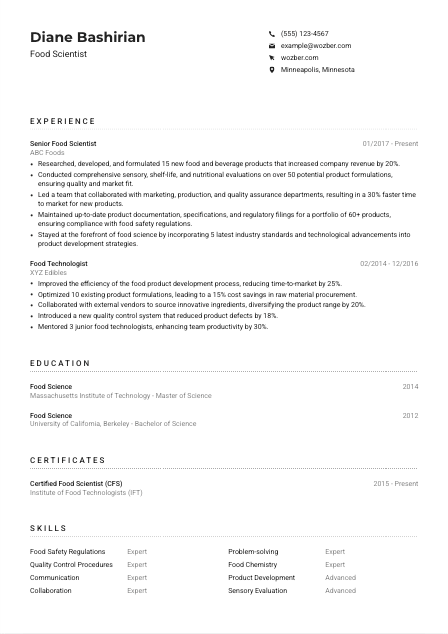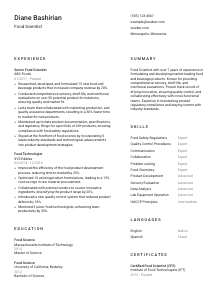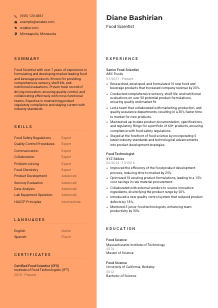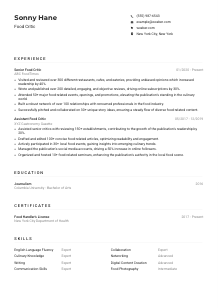Food Scientist Resume Example
Experimenting with flavors, but your resume tastes bland? Dive into this Food Scientist resume example, cooked up using Wozber free resume builder. See how effortlessly you can infuse your food innovation skills with job criteria, ensuring your career rises as delectably as a perfectly baked soufflé!

How to write a Food Scientist resume?
Hello, budding Food Scientist! In a world where blending ingredients can lead to the next big flavor sensation, your resume is the recipe you need to concoct to captivate your next employer. With the culinary science field as competitive as it is innovative, presenting a resume that stands out is essential.
Fear not, for the Wozber free resume builder is the secret ingredient you've been seeking. This guide will escort you through creating a resume harmonized with your dream role's demands - let's whip up a resume that's as mouth-watering as your food innovations!
Personal Details
An appetizing personal details section is more than just listing your name and contact info—it's an amuse-bouche that entices employers to learn more about you. By customizing this section for the Food Scientist position, it communicates you're not just another fish in the sea. Here's how to make it savory and appealing.
1. Brand Yourself with Your Name
Your name is the label on your professional product. Ensure it's in a clear, readable font that stands out—think of it as your personal brand logo on your resume's package.
2. Tailor Your Title
Just below your name, craft your tagline. Use the position title, "Food Scientist," exactly as listed in the job description. This quick tag aligns you with the job from the get-go, serving to immediately align your application with what the hiring manager is looking for.
3. Essential Contact Ingredients
Include only the freshest contact details: a phone number you're always available at and a professional email address—preferably in the firstname.lastname@email.com format. This ensures a clean, professional impression.
4. Location, Location, Location
Highlighting "Minneapolis, Minnesota" as your location ties you to the job's geographical requirements. It tells your future employer you're already in the mix or willing to relocate, making the logistics as smooth as your finest cream.
5. Professional Profiles: The Cherry on Top
Adding a link to a comprehensive LinkedIn profile can provide depth to your resume. Make sure it's trimmed and pruned to mirror the professional excellence you're showcasing on your resume.
Takeaway
Initial impressions are key in whisking your way to success. Make sure your personal details are not just complete but are curated to match the essence of being a Food Scientist. Think of it as the first taste that makes the hiring manager crave more.





Experience
Your experience section is like your main course—it must be rich and fulfilling, showcasing the sumptuous meals you've crafted in your career. Here's how to marinate your experiences to reflect your suitability for the Food Scientist role perfectly.
- Researched, developed, and formulated 15 new food and beverage products that increased company revenue by 20%.
- Conducted comprehensive sensory, shelf‑life, and nutritional evaluations on over 50 potential product formulations, ensuring quality and market fit.
- Led a team that collaborated with marketing, production, and quality assurance departments, resulting in a 30% faster time to market for new products.
- Maintained up‑to‑date product documentation, specifications, and regulatory filings for a portfolio of 60+ products, ensuring compliance with food safety regulations.
- Stayed at the forefront of food science by incorporating 5 latest industry standards and technological advancements into product development strategies.
- Improved the efficiency of the food product development process, reducing time‑to‑market by 25%.
- Optimized 10 existing product formulations, leading to a 15% cost savings in raw material procurement.
- Collaborated with external vendors to source innovative ingredients, diversifying the product range by 20%.
- Introduced a new quality control system that reduced product defects by 18%.
- Mentored 3 junior food technologists, enhancing team productivity by 30%.
1. Distill the Job Requirements
Commence by dissecting the job description, much like how you would analyze a new formula. Identify and note the experiences that resonate with phrases like 'formulated new food products' or 'ensured compliance with food safety regulations.'
2. Recipe Format
Serve your experience in a digestible format: most recent achievements first. Outline the role, the dining establishment (company), and the dates you served there. It's like arranging the courses of a meal.
3. Ingredient List (Accomplishments)
For each role, list the recipes for success you've concocted—those achievements that echo the job's demands. Did you develop a new snack that became a market leader? Quantify its success. This translates your value into concrete results.
4. Measure Your Success
Incorporate metrics into your accomplishments—tangible evidence of your impact. Did your innovation reduce product development time? Specify by how much. Quantitative achievements are like the secret sauce, adding flavor to your narrative.
5. Relevancy is Key
While your sideline as a pastry chef might be impressive, focus on the experiences that are directly relevant to being a Food Scientist. Highlight your roles in product development, quality assurance, or any area mentioned in the job description.
Takeaway
Imagine your experience section as a professionally curated tasting menu. Every item should entice and inform, proving you're not only a match for the Food Scientist role but a delightful choice. Showcase your career delicacies with confidence.
Education
A well-leavened education section can prove you've got the base knowledge to rise to the occasion. Tailoring your academic achievements for the Food Scientist role illuminates your foundational expertise in the field.
1. Pick the Prime Ingredients
Pinpoint what the job description emphasizes in terms of educational background, like a "Bachelor's degree in Food Science." Ensure these requirements are clearly listed in your education section.
2. Neatly Package Your Degrees
A clear, understandable layout is key. List your degree, the field of study, and the alma mater, followed by the year you graduated. This organized format is like recipe instructions—easy to follow, ensuring nothing is missed.
3. Match Degree Titles
Directly reflect job criteria by listing your degrees verbatim, if possible. If the job prefers a "Master's degree," and you have one, place that at the forefront. This signals a perfect match to the recruiter.
4. Relevant Courses and Certifications
Highlight courses or certificates that add an extra layer of specialization to your qualification, especially if you are in the early stages of your career. Just like adding spices enhances a dish, this adds depth to your educational profile.
5. Educational Achievements and Extras
Did you graduate with honors, or were you part of the food science club? These tidbits add character and show your dedication beyond the classroom. However, assess their relevance based on your career level—let your achievements age as well as a fine wine.
Takeaway
Think of your Education section as the dough of your professional bakery—it needs to be solid yet flexible, forming the base of your resume. Ensure it's reflective of your qualifications and aligns with the culinary craftsmanship the role demands.
Certificates
In the culinary world of food science, certifications are like the spices in your pantry—they can elevate your profile and show your commitment to continuous learning. Sculpt your certificate section to amplify your proficiency and passion.
1. Sift Through the Job's Demands
Begin by identifying if there are any preferred, desired, or required certifications directly mentioned in the job description.
2. Prioritize Pertinent Certificates
Highlight those certifications like 'Certified Food Scientist (CFS)' that directly enhance your suitability for the role. This is prioritizing quality over quantity; make sure the hiring manager spots these qualifications at first glance.
3. Freshness Counts
If your certification has a validity period or it's a recent achievement, including the date is like ensuring your ingredients are fresh. This demonstrates your up-to-date knowledge and eagerness for professional growth.
4. Stay Current
The food industry is always evolving, and so should your certifications. Regularly refreshing your knowledge and certifications keeps you competitive and versatile, much like keeping your spice rack stocked with the latest flavors.
Takeaway
Certifications can offer your resume that extra zest, making your application more flavorful and memorable. Continually updating and expanding your certifications demonstrates an ongoing commitment to excellence and innovation in the food science field.
Skills
Think of your skills section as the seasoning of your resume—the right mix can enhance the whole dish. Here's how to select and present your skills to match the Food Scientist role, ensuring a balanced and enticing flavor.
1. Extract from the Recipe
Start by skimming through the job description to discern both explicitly mentioned and implicitly required skills. Keywords like 'food safety regulations' and 'quality control procedures' should jump out at you.
2. Measure Your Ingredients
List the skills that you possess, which directly align with the job requirements. Strike a balance between hard skills, such as 'lab equipment operation,' and soft skills, like 'problem-solving,' to demonstrate versatility.
3. Organize for Taste
Keep your skills section neat and easily digestible. Prioritize the skills most relevant to the job at the top. This ensures the hiring manager can quickly see how your skillset flavors match up with the job's needs.
Takeaway
The skills section presents a quick bite of what you bring to the table. It's your chance to make the hiring manager's taste buds tingle with your professional prowess. Handpick your skills like you would your ingredients, ensuring they complement the culinary masterpiece that is your resume.
Languages
In the diverse world of food science, being multilingual can set you apart in the global market. Let's look into how to effectively showcase your linguistic skills on your resume.
1. Check the Menu
Begin by noting if the job description specifies any language requirements, like "English speaking skills are mandatory." Place them front and center.
2. List Your Fluency Levels
Starting with the required languages, list your fluency levels clearly. Being honest about this gives a transparent and credible impression.
3. Add Flavors
Knowing additional languages can add depth to your application. List them in a way that highlights your versatility and readiness to engage in a global market.
4. Be Candid About Proficiency
Clearly specify your proficiency level for each language. Whether you're 'Fluent' or at an 'Intermediate' level, your honesty prepares future employers for how you can contribute to international teams.
5. Embrace the Global Palette
For roles that emphasize international exposure or dealing with diverse consumers, showcasing your multilingual abilities can give you an edge. Even basic proficiency demonstrates your adaptability and openness to global influences.
Takeaway
Languages add a nuanced flavor to your professional profile. They symbolize not just your ability to communicate but also your capability to immerse in diverse cultures and consumer bases. Embrace and highlight your language skills as a testament to your global culinary nous.
Summary
Your summary is the appetizer of your resume—it sets the stage for what's to come. Crafting a compelling summary ensures the hiring manager is eager to digest the rest of your resume. Let's get into how to create a savory introduction.
1. Understand the Dish
Begin by absorbing the essence of the job. Think about what makes a Food Scientist indispensable, and how your unique blend of skills, experience, and education make you the perfect recipe for the role.
2. Start with a Flavorful Introduction
Lead with a sentence that encapsulates your professional identity. A statement like, 'Food Scientist with over 7 years of experience...' immediately situates your expertise in the context of the role.
3. Blend In Key Ingredients
Sprinkle in a few of your standout skills and accomplishments, focusing on those directly related to the job's requirements. This quick taste should leave them craving the detailed courses (sections) that follow.
4. Keep It Light and Savory
Your summary should be a delicate balance of enticing and informative, without overloading the palate. Aim for 3-5 sentences that invite the hiring manager to indulge in the feast of your full resume.
Takeaway
The summary is your chance to make an immediate, impactful connection with the hiring manager. It's the amuse-bouche that leaves them eager for the main course—your career experiences, skills, and achievements. Craft it with care, infusing your personal flavor while aligning with the role's requirements.
Crafting Your Culinary Masterpiece
Congratulations for whisking through the essential ingredients of a compelling Food Scientist resume! By using these strategies, coupled with the tools available on the Wozber free resume builder, you're fully equipped to bake your resume to perfection. Remember, like in any great recipe, your personal touch makes the difference.
Use the ATS-friendly resume template and ATS resume scanner to ensure your resume not only meets but exceeds the appetite of hiring managers. Your culinary career awaits—time to serve up your masterpiece!

- Bachelor's degree in Food Science, Food Technology, Chemistry, or a related field;
- Master's degree preferred.
- Minimum of 3 years of experience in a food product development or research setting.
- Strong knowledge of food safety regulations and quality control procedures.
- Proficiency in the use of laboratory equipment and software systems for data analysis.
- Excellent communication, collaboration, and problem-solving skills.
- English speaking skills are mandatory.
- Must be located in or willing to relocate to Minneapolis, Minnesota.
- Research, develop, and formulate new food and beverage products based on market trends and consumer insights.
- Conduct rigorous sensory, shelf-life, and nutritional evaluations of potential product formulations.
- Collaborate with cross-functional teams including marketing, production, and quality assurance to ensure product success and safety.
- Maintain and update product documentation, specifications, and regulatory filings.
- Stay abreast of the latest industry standards, scientific findings, and technological advancements to continually enhance product portfolios.















